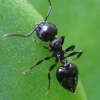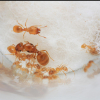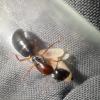Update 10 (29/1/19)
So here it is - the long awaited 10th updated (long awaited by me at least). I'd say I waited 2 months to post because nothing interesting happened, but frankly I just forgot last Termite Tuesday and couldn't be bothered to post on any other day. So instead I'm here, posting on the first Termite Tuesday of 2019, instead of doing homework.
Anyways, I've devised a "new" method for keeping my termites. It's actually what's generally recommended in a ton of scientific papers. And it's really easy: just a container of any sort with some substrate and cellulose. In this case, my container is a petri dish, my substrate is sand (sifted aquarium sand because I was stupid enough to buy the wrong stuff - for the second time), and the cellulose is coffee filter paper, because I don't have the proper stuff. Anyhow, my termites seem happy enough in the setups.

The setup before the termites are added.

The setup after the termites are added. These dishes aren't airtight, so they don't lock together. I add an elastic band just to make sure they don't spill open if they fall.

Here's some brachypterous neotonics chilling on the paper. Colonies seem to dig lots of tunnels and then just stand on the surface.
I should explain what happened to all of my different setups. As of right now, I have 3 petri dish setups: One contains the individuals from the mainly neotonic test tube, as well as the individuals from the test tube with two soldiers. The second dish contains all of the individuals from the one remaining jam jar setup - there were a lot more individuals in that one than I expected, at least 10 or 12 neotonics, and maybe 30 or 40 workers. They've settled in nicely and have made a sand tube from their nest entrance to the filter paper. The final dish is all of the individuals from the two remaining tubes. Neither seemed to be doing very well, so I chucked them both in a dish and let them be. There's probably less than 30 individuals, only 1 fully formed neotonic, and a soldier. We'll see what happens with them.
I managed to get some neat shots of the neotonics - the good thing about the petri dish is that it's much easier to take nice photos. Everything's still blurry, but I'm working on it - supposedly by increasing capture rate I can get things like antennae in focus more easily.

Headshot.

Some grooming action going on here. Even though it's blurry, you can still see some of the interesting anatomical features of the termite.

More grooming.

Another headshot.
I also managed to grab some good photos of one of the soldiers - it was out and about, and would freak out if I lifted the lid off. Pinchy little things. They're fun to fight with tweezers.



Here's a picture of one of the dishes from the bottom after the termites had been in there for a day or three. As you can see, they like to dig.

More research into records and old papers has revealed that the locations of termite colonies in my city are well known, because they're invasive and a large economic pest. As it turns out, all of the termites I collected were from the same colony, which I had suspected. Anyhow, when merged, they don't fight, though reproductives of different shards will often kill eachother. None of the neotonics were harmed in the various fusions it seems, though some nymphs and subsequent instars were. The dark splotches are apparently bite marks.

This one's got the thorax of a reproductive and the abdomen of a worker. It's kinda odd.

I think this is the same individual, after I removed its corpse from the dish.
I also got some neat pictures of normal termite stuff.

Here's a worker - it's blurry, but again, you can see some of the anatomical details and the colours. Some termites are rather interesting to look at.

Here's a neotonic surrounded by its cohort. I think it's actually just getting in the way of a dig, but the first explanation sounds cooler.

Here's some grooming action - you can really see the details on the side of the reproductive. It looks almost identical to an alate of this species, just unpigmented.

You can see a termite placing a grain of sand at the top of this image. They always place the grain, and then twist it on with their head. I've seen videos of Macrotermes in Africa doing the same with globs of mud. It's interesting how similar this behaviour is, even though the two species are on different sides of an ocean.
Finally, here are some more soldier pics - this one was the soldier in the third dish. It was the last individual in the tube, and so it got to stay a bit longer in an empty lid for a photoshoot. Again, the photos aren't the sharpest, but I'm working on it.



So that about wraps it up for this update. Still no eggs or brood as far as I can see. It could be because it's winter (termites of this species in the northern range tend to take a break from egg laying during the winter), or it could be because the colonies are too small. I spoke to someone who recommended colonies of about 40 or 50 individuals (roughly what I have), and I emailed someone else who recommended colonies in the hundreds just to get started "too many for a petri dish". Come springtime, I'll be visiting some of the sites where potential colonies are, and be focusing on creating a larger setup, to see if I can finally get a colony going.
Anyways, it'll probably be a little while until I update again, or else the updates will be shorter. I'm committed to trying to leave my termites alone so fewer photoshoots and no more setup moves.






























































































































